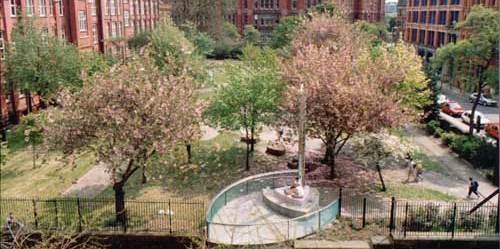
|
Manchester, England United Kingdom |
Sackville Gardens, near Canal Street | Beacon of Hope |
since 1 December 2000 without names |
The Beacon of Hope was conceived in 1997 as Manchester's answer to the threat of HIV/AIDS. It was designed by competition winners Warren Chapman and Jess Byrne-Daniels.
The design consists of a series of elements combining together the existing 'Tree of Life' with the 'Beacon of Hope' light sculpture. They describe a metaphorical journey through life, providing the opportunity for remembrance, contemplation and celebration.
The 'Tree of Life', was planted on World AIDS Day 1993, and provides the starting point of the metaphorical journey. It is often used as a place to spread ashes and to leave floral tributes.
Three plinths are placed between the Tree of Life and the Beacon, to provide a visual and metaphorical link between the two elements. Metaphorically the plinths may represent the three stages of life: youth, maturity and senescence.
The Beacon of Hope, at the edge of the path, terminates the 'path of life'. The prow like shape of the podium has direct reference to the adjacent canal and may also have symbolic reference to the start of the next unknown journey.
The plinth upon which the beacon sits is covered in mosaic tiles in varying colours and shades. Within, a time capsule has been placed which contains messages to loved ones affected by HIV & AIDS, these can be updated annually as part of ceremonies associated with World AIDS Day.
The Beacon, a spiralling stainless steel column erected in 2000, rises from the mosaic plinth. Its' internal illumination provides nocturnal interest and reference to the HIV/AIDS candle lit vigils held throughout the world.
The engraved and pierced hearts on the column gesture towards fragile lives and loves lost to HIV/AIDS, and to the compassion needed throughout society to help control its increase and spread.
Lesbian and Gay Foundation
The design consists of a series of elements combining together the existing 'Tree of Life' with the 'Beacon of Hope' light sculpture. They describe a metaphorical journey through life, providing the opportunity for remembrance, contemplation and celebration.
The 'Tree of Life', was planted on World AIDS Day 1993, and provides the starting point of the metaphorical journey. It is often used as a place to spread ashes and to leave floral tributes.
Three plinths are placed between the Tree of Life and the Beacon, to provide a visual and metaphorical link between the two elements. Metaphorically the plinths may represent the three stages of life: youth, maturity and senescence.
The Beacon of Hope, at the edge of the path, terminates the 'path of life'. The prow like shape of the podium has direct reference to the adjacent canal and may also have symbolic reference to the start of the next unknown journey.
The plinth upon which the beacon sits is covered in mosaic tiles in varying colours and shades. Within, a time capsule has been placed which contains messages to loved ones affected by HIV & AIDS, these can be updated annually as part of ceremonies associated with World AIDS Day.
The Beacon, a spiralling stainless steel column erected in 2000, rises from the mosaic plinth. Its' internal illumination provides nocturnal interest and reference to the HIV/AIDS candle lit vigils held throughout the world.
The engraved and pierced hearts on the column gesture towards fragile lives and loves lost to HIV/AIDS, and to the compassion needed throughout society to help control its increase and spread.
Lesbian and Gay Foundation





























